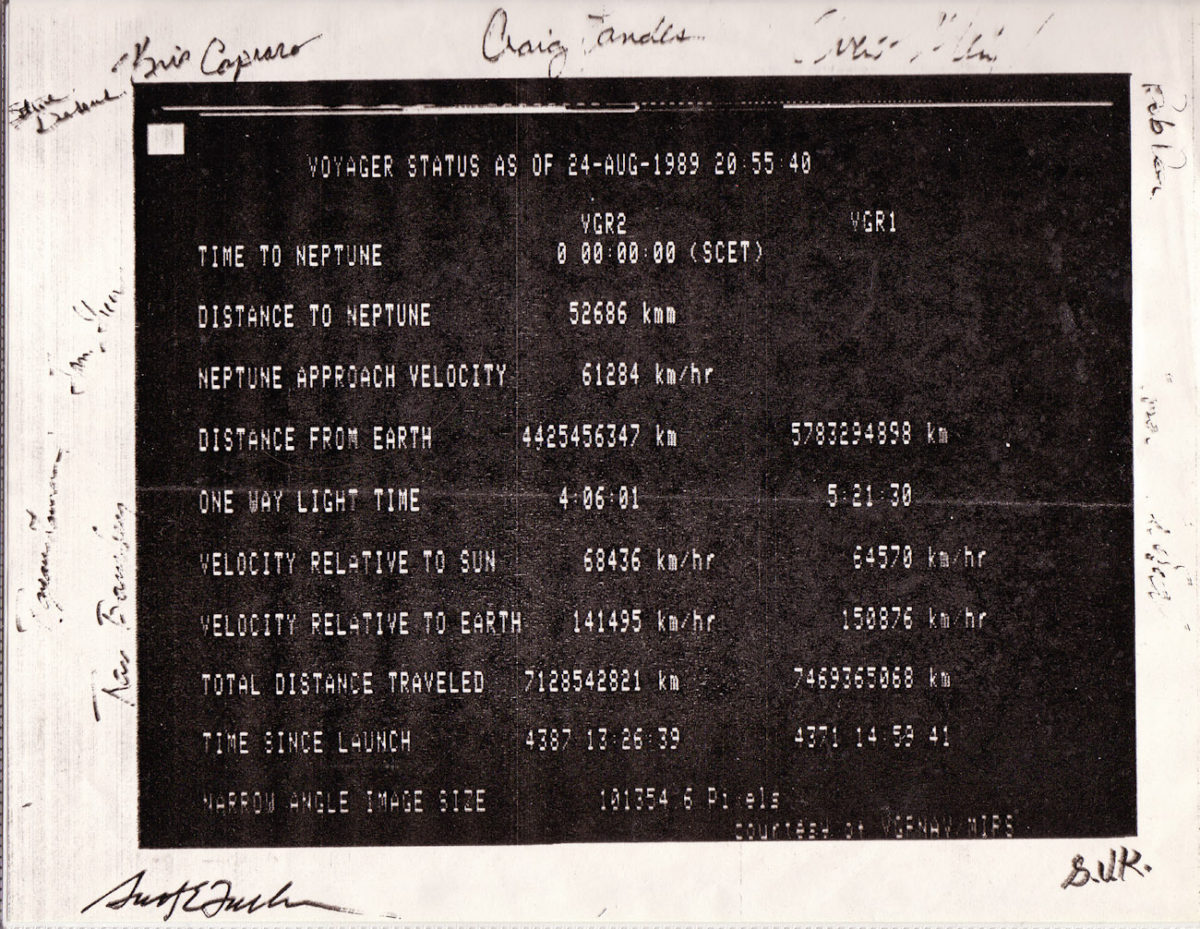Emily Lakdawalla • Nov 24, 2010
Final set of Voyager Mission Status Bulletins: The Voyager 2 Neptune flyby and beyond
I'm surprised no one's emailed me demanding the last batch of Voyager mission status bulletins! Well, here they are, available in one big archive (in a zip file linked from the top of the page) or in single PDFs. When we last left our hero, it was February 1986 and the Uranus encounter had just been completed. In retrospect I should have included number 81 -- published March 21, 1988 -- with the Uranus flyby, because it summarized what was learned from that encounter.Number 82 was the first 8-pager to date and much more polished-looking than its predecessors. The first of these bulletins felt like in-house newsletters, intended for an audience of engineers and geeks. By the time of the Neptune encounter, the newsletters were clearly a public information product of the Jet Propulsion Laboratory, with language intended for a wider audience. There's some cost in detail about the spacecraft's engineering status, but insofar as the change is symptomatic of the public interest in the Voyager mission it is a good sign.
As Voyager 2 bore down on Neptune, the bulletins talked about how the engineers were teaching the spacecraft to be smarter and upgrading the Deep Space Network in order to make the most of the low light and the incredible faintness of Voyager 2's signal at Neptune's distance from the Sun. By bulletin number 83 on August 1, 1988, Voyager 2 was already getting better resolution than Earth-based telescopes, and was using both its processors (primary and backup) to enable data compression for real-time image transfer, the kind of thing they'd never even have been allowed to do at Jupiter.

That Voyager was a flagbearer for the coming renaissance in robotic space exploration was made clear in bulletin number 84, which marked the end of the lean years of robotic space exploration with the following table:
| A Look at 1989 in Space Exploration | |
|---|---|
| January 29 | Soviet Phobos II Spacecraft enters Mars orbit |
| February | Third Tracking and Data Relay Satellite (TDRS) launches |
| April | Soviet Phobos II lands on Phobos |
| April 28 | Magellan Venus radar mapper mission launches |
| June 5 | Voyager Neptune Encounter period begins |
| August 25 | Voyager 2's closest approach to Neptune |
| October 2 | Voyager 2 Neptune Encounter ends |
| October 12 | Galileo Jupiter orbiter and probe mission launches |
| December 11 | Hubble Space Telescope launches |
Number 85 has a detailed review of spacecraft systems and health. Number 87 marks another sign of changing times with the notice of the addition of Soviet scientists to the team -- Alexander Basilevksy, Vladimir Krasnopolsky, and Lev Zelenyi. The following several updates, covering July and August 1989, included new discoveries on each page; Neptune, being farther than Uranus (hence more interesting from a greater distance to a flyby spacecraft) and also being a bit more forthcoming with its secrets than its bland neighbor, really put on a spectacular show for Voyager. And then there was Triton, discussed in number 94, as a "stunning finale." With its possible origin in the Kuiper belt, Triton's exploration by Voyager 2 was not so much icing on the cake as it was a promise of untold wonders lying out there beyond Neptune, waiting to be explored by Voyager's successors.

The final two bulletins, numbers 98 and 99, detail the plans and then the accomplishment of Voyager 1's iconic solar system family portrait. NOTE: The previous sentence has been changed to identify the correct spacecraft.
And that was it. The Voyagers' cameras were turned off. Since the mission status bulletins were probably most anticipated for the images they contained, there was no reason to continue the newsletter. And the Internet arrived soon after that, making such printed documents with their lengthy delivery delays seem archaic almost overnight. Yet, even though it's been more than twenty years since the last Voyager newsletter was mailed, those spacecraft are still functioning out there in the deep dark, beyond the sway of the planets.

Support our core enterprises
Your support powers our mission to explore worlds, find life, and defend Earth. You make all the difference when you make a gift. Give today!
Donate

 Explore Worlds
Explore Worlds Find Life
Find Life Defend Earth
Defend Earth

